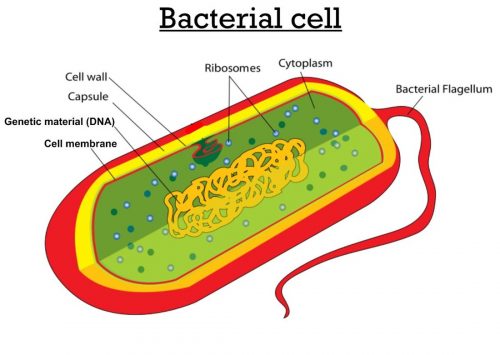
What is a cell?
A cell is the basic building block of life [1]. It is the smallest structural and functional unit that can copy themselves independently. We humans have several trillions of cells in our body. These cells work together beautifully and let us function like a well oiled machine.
The bacteria are unicellular organisms. They have a simple structure. Animals are usually multi-cellular organisms and have more complex structure than those of bacterial cells. Moreover, the animal cells in higher multicellular organisms coordinate with each other function as one organism. Although bacterial cells also co-ordinate and form biofilms, they do not function as one organism but a group of organisms [2].
The cells can broadly be classified into two types: Prokaryotic cell and Eukaryotic cell. The word Prokaryote comes from “Pro” which means before and “karyon” meaning nut or kernel resembling nucleus. Eu stands for easily from karyon or kernel. This classification is based on the absence or presence of organelles bound by membranes like nucleus. In general, the eukaryotic cells are more complex than the prokaryotes. Bacterial and Archeal cells are prokaryotic while Protists, fungi, plant and animal cells are eukaryotic cells [1].
What are the major differences between a bacterial cell and an animal cell?
The bacterial cell and animal cells differ from each other mainly due very prominent differences in structure and organization [3]. Their major differences are described below:
- Nucleus: The most important difference between a bacterial cell and animal cell is that the bacterial cell does not have a membrane-enclosed nucleus. Instead, the bacterial cells keep its genetic material in an irregularly spaced region called nucleoid. The nucleoid consists mainly of DNA, but also some RNA and proteins. The RNA component is mostly messenger RNA. The proteins present in the nucleoid are mostly DNA binding proteins like HU, HNF, IHF and several others. These proteins are called nucleoid-associated proteins. Bacterial cells do not have histones and the DNA is not compacted into nucleosomes. In bacteria, the DNA is compacted by the mechanism of DNA looping where DNA is bend, bridged and aggregated [4].
The nucleus of an animal cell is fully enclosed in a membrane called nuclear membrane. The transport of proteins across the nuclear membrane is facilitated by the presence of pores called nuclear pores. The nucleus of an animal cell also has subcellular organelles like nucleolus which function in synthesis rRNA and assemble ribosomes. Animal cells are characterized by presence of histone proteins and nucleosomes.
- Cell size: Bacterial cells are usually much smaller than animal cells. Bacterial cells are usually 0.2 to 10 micron in size where are animal cells can be 100 microns or larger.
- Cell wall: The bacterial cell have a well-defined cell wall, an animal cell does not. The cell wall mainly consists of peptidoglycan (also called murein). Peptidoglycan is responsible for the rigidity of the bacterial cell. Bacterial cell wall can be classified into two different types, those of Gram-positive bacteria and those of Gram-negative bacteria differentiated by their Gram staining properties. The susceptibility of bacteria is due the presence of their cell wall. The beta- lactam group of antibiotics like penicillin inhibits the peptide-glycan crosslink formation and thus kills the bacterial cells. The animal cells lack cell wall and are protected from the effects of these antibiotics. This difference is very important as the antibiotics we eat do not affect our normal healthy body cells but kill the infecting bacteria. The exceptions are mycoplasma, which are bacteria with out a cell wall and are thus not susceptible to antibiotics.
- Cell shape: A bacterial cell consists of several shapes like coccus (spherical), bacillus (rod like), filamentous (elongated), spiral (DNA like) etc. whereas animal cells lack cell wall and are irregular in shape. Peptidoglycan in cell wall is also responsible for the shape of the bacterial cell. As the animal cells do not have a cell wall, it does not have a defined and rigid cell shape. The plasma membrane forms the outer boundary of an animal cell. The plasma membrane is semi permeable that means it allows selective molecules to pass through it. Plasma membrane is composed of a lipid bilayer that is not as rigid as a bacterial cell wall.
- Metabolism Bacterial cells can be classified into autotrophs or heterotrophs depending on the carbon source they use for metabolism. The word autotroph is derived from Greek word “Autos” meaning self and trophe “meaning” nourishing. The autotrophs are organisms that use simple source of carbon like carbon dioxide to derive energy and make complex carbon compounds like carbohydrates. The heterotrophs, on the other hand uses complex sources of carbon like carbohydrates to derive energy. The bacterial cells are autotrophs and animal cells are heterotrophs. The bacterial cells can be phototrophs, lithotrophs or organotrophs. The phototrophs use light as a source of energy. The lithotrophs use inorganic compounds as their source of energy and organotrophs use organic compounds as their source of energy [5].
- Reproduction Most bacterial cells reproduce asexually by binary fission and sexually by conjugation. The reproduction of animal cells on the other hand, is much more complex. The animal cells can asexually reproduce by mitosis and sexually by meiosis. Sexual reproduction is the most common for of reproduction in animal cells. Sexual reproduction in animal cells requires the presence of two parents whereas one bacterial cell can reproduce on its own. Sexual reproduction leads to genetic variability in the daughter cells. This is one of the hallmarks of evolution.
- Plasmids Bacterial cells have plasmids in their cytoplasm whereas animal cells do not. The bacterial cells usually have a much simpler genomic structure than animal cells.
- Mitochondria Bacterial cells do not have mitochondria whereas animal cells have mitochondria in their cytoplasm.
- Fimbria DNA transfers: Some bacterial cells have Fimbriae DNA transfer but no animal cells do so [5].
- Mobility with Flagella Some bacteria can be move with flagella but animal cells do not have flagella like structure to help them move.
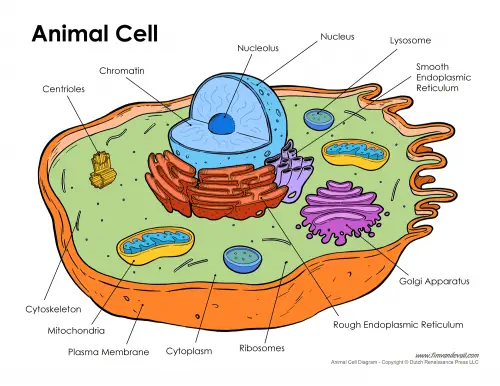
The differences described above are listed in a tabular form below.
| Characteristics | Bacterial cells | Animal cells |
| Nucleus | Do not have a nucleus, they have a nucleoid | Have a membrane bound nucleus |
| Cell size | Very small, 0.2 micron to 10 micron in size | Larger than bacterial cell, can be larger than 100 micron |
| Cell wall | Has cell wall, made of
peptidoglycan |
No cell wall |
| Antibiotic sensitivity | Sensitive to antibiotic | No sensitive to antibiobic |
| Cell shape | Has defined cell shape | Irregular in shape |
| Metabolism | Autotroph as well as heterotroph | Only heterotroph |
| Reproduction | Asexual mode: Binary fission
Sexual Mode: Conjugation |
Asexual mode: Mitosis
Sexual mode: Meiosis |
| Plasmids | Has plasmids | Do not have plasmids |
| Mitochondria | Has no mitochondria | Has mitochondria |
| Fimbria DNA transfer | Some bacteria has Fimbria | Has no Fimbria |
| Mobility with Flagella | Some bacteria have flagella to move, some do not | No flagella |
There are some other minor differences between the bacterial and animal cells that are important but are not described in detail above. These differences are listed in the tabular form below:
| Characteristics
Ribosomes |
Bacterial cell
Contains 70S, small ribosomes |
Animal cell
Contains 80S, larger ribosomes |
| Centrioles | Do not have centrioles | Have centrioles |
| Lysozyme | Do no lysozyme | Have lysozyme |
| Organelle | No organelle | Several membrane bound organelles present |
| DNA | Circular DNA in cytosol | Linear DNA in nucleus |
| Chromosome | Single chromosome | Several chromosomes |
| Cytoskeleton | Lacks cytoskeleton | Has cytoskeleton |
| Histone | No histones | DNA is wrapped around by histones |
| Golgi apparatus | No golgi apparatus | Has golgi apparatus |
| Endoplasmic reticulum (ER) | No Endoplasmic reticulum | Has endoplasmic reticulum |
Why are the bacterial cells and animal cells so different?
A bacterial cell is composed of a single cell. It needs to be self sufficient for survival. Apart from the common features like reproduction and metabolism, it has additional features like flagella for mobility. Whereas animal cells are multicellular. Millions of animal cells can come together and serve a common function or several different functions.
Conclusions
The cellular organization is the reason what makes a bacterial cell and an animal cell remarkably different. The bacterial cells are primitive and simpler, yet so much new is still being discovered each day. The comparative simplicity of bacterial cells makes it easier to research and this research, on the other hand helps a better understanding of the more complex animal cells. It is safe to conclude that the bacterial cells and animal cells are very different in several aspects of cellular organization as well as their biological functions.
Author: Debashree Basu
Debashree received her PhD in Biochemistry and specialized in infectious diseases. She is a Research Scientist whose main focus is bacteria, yeast and mammalian cells. She published articles in peer reviewed journals.

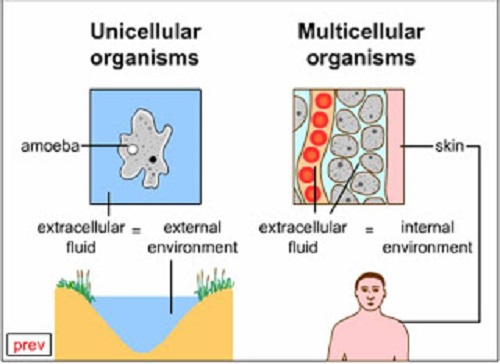
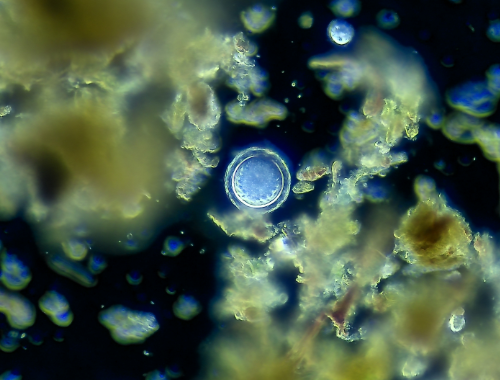

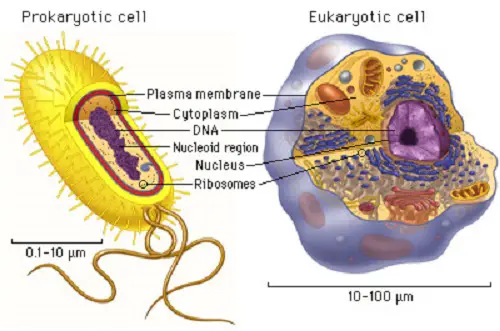







Leave a Reply